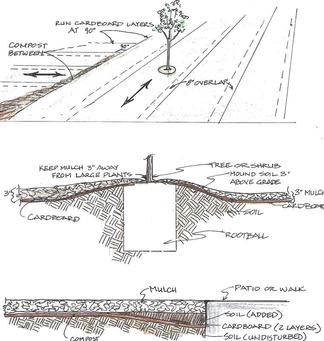Sheet Mulching
Sheet mulching is an excellent method of removing a lawn and preparing a site for planting. Instead of stripping off the lawn and hauling it away, a thick layer of organic material is laid on top of the lawn or bare ground. Over time, grasses and weeds break down to enrich the soil, and new planting beds remain neat and weed free.
Sheet mulching is an excellent method of removing a lawn and preparing a site for planting. Instead of stripping off the lawn and hauling it away, a thick layer of organic material is laid on top of the lawn or bare ground. Over time, grasses and weeds break down to enrich the soil, and new planting beds remain neat and weed free.
Materials:
Cardboard rolls:
415 sf coverage per roll (250' x 4') as double layer, incl 8" overlap
Available from Urban Farmer in Richmond (510) 524-1604 for $100
Compost:
1" deep minimum (3 cubic yards per 1,000 square feet)
Mulch:
3" deep minimum (9 cubic yards per 1,000 square feet)
Water:
Although the goal of this process is to reduce water usage, be generous with applications of water between each layer to speed the decomposition of the material.
Cardboard rolls:
415 sf coverage per roll (250' x 4') as double layer, incl 8" overlap
Available from Urban Farmer in Richmond (510) 524-1604 for $100
Compost:
1" deep minimum (3 cubic yards per 1,000 square feet)
Mulch:
3" deep minimum (9 cubic yards per 1,000 square feet)
Water:
Although the goal of this process is to reduce water usage, be generous with applications of water between each layer to speed the decomposition of the material.
Process:
Check for bermuda or other noxious weeds that may require additional removal steps. See blog entry for removal of bermuda and other difficult weeds.
Check for bermuda or other noxious weeds that may require additional removal steps. See blog entry for removal of bermuda and other difficult weeds.
- Cut lawn and/or weeds as short as possible with mower on lowest setting.
- Dig a 2-4" deep x 12-18" wide trench near all walkways and patios to allow room for sheet mulch layers.
- Optional 1" layer of compost.
- Plant larger trees and shrubs 5 gallon, 15 gallon, and larger
- Water soil area thoroughly.
- Lay out cardboard over entire area, overlapping sides by 8". Tear or cut cardboard to lay around shrubs and trees, keeping cardboard 2-3" away from plant crowns.
- Water well
- Spread a 1" layer of compost over the cardboard. Be very careful while walking over the cardboard, as it will be very delicate. Walk on top of compost layer only.
- Lay out another layer of cardboard crossing in the other direction, overlapping as before.
- Run drip irrigation lines over cardboard, under mulch
- Water well
- Spread 3" mulch over cardboard
- Plant smaller shrubs, perennials, groundcovers, cutting through cardboard as needed.
Summary:
This is a fun, easy, and quick project to do yourself. It's hard to mess it up- just keep a couple of points in mind:
https://www.marinwater.org/158/Sheet-Mulching-Guide
This is a fun, easy, and quick project to do yourself. It's hard to mess it up- just keep a couple of points in mind:
- Cardboard has to be solid and thick keep out light to kill weeds, so if it tears, patch it up.
- Adding organic matter encourages soil organisms to wake up and break down the weeds while enriching the soil.
- A thick layer of mulch keeps out the weeds- and any that do sprout will just pull out effortlessly. It also keeps in the moisture necessary for breaking down the lawn/weeds, and keeping the soil organisms happy.
- Small groundcovers and perennials can be planted directly in the mulch layer. It's best to throw in a shovelful of soil or planting mix and/or compost with them to help hold moisture, but they do very well with sheet mulching.
- Additional web sites offering various methods, ideas about sheet mulching:
https://www.marinwater.org/158/Sheet-Mulching-Guide
Congratulations!
You've reduced landfill waste and improved your soil! You'll be enjoying a beautiful, healthy, drought tolerant garden for years to come!
Materials calculator:
Example: 1,200 square feet
1,200 x .00925 = 11 cubic yards of mulch needed
11 x .333 = 3.66 cubic yards of compost - round up to 4 cubic yards- better to have more
1,200 / 415 = 2.89 rolls- round up to 3 rolls
You've reduced landfill waste and improved your soil! You'll be enjoying a beautiful, healthy, drought tolerant garden for years to come!
Materials calculator:
- Area to sheetmulch________ (A)
- Multiply (A) x .00925 to get cubic yards of mulch needed (3") :
- Take the cubic yards of mulch, multiply that number by .333 to get cubic yards of compost
- Area divided by 415. Round up to get number of cardboard rolls needed.
Example: 1,200 square feet
1,200 x .00925 = 11 cubic yards of mulch needed
11 x .333 = 3.66 cubic yards of compost - round up to 4 cubic yards- better to have more
1,200 / 415 = 2.89 rolls- round up to 3 rolls

 RSS Feed
RSS Feed
